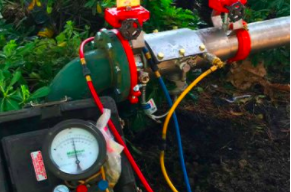They are making a number of good points on the subject of Is backflow testing necessary? as a whole in this content directly below.

Yes, you need to backflow test your home's supply of water to make sure that the water is without toxins and also unsafe degrees of chemicals. You must not attempt to do backflow screening on your own since of the equipment needed and space for mistake. We recommend that you call a specialist plumber every couple of years to check your water.
What is Backflow?
In other words, backflow is when water moves upwards-- the opposite instructions in the plumbing system. This is additionally known as "backpressure." When the water moves in this direction, it can combine with unsafe toxins and position a risk.
What Triggers Heartburn?
A regular cause of backflow is a loss of water pressure that triggers the water to siphon back right into the water. An instance is cleaning a paint bucket making use of a pipe. You fill up the paint container up with water, leaving the hose in the container. After time, there is a loss in water stress and the hose starts to draw the water back into the supply of water. As you can visualize, there are currently chemicals from the paint that are entering the water, potentially posing a hazard. Regrettably, many people are not also aware of heartburn screening, however there are several reasons it's so vital.
Backflow Screening is Needed by Law in Particular Cities
Relying on where you live, you could in fact be required by legislation to backflow test your regulation. For instance, Iowa City maintains a record of all residential properties served by the city's water system. The city requires that particular "high-hazard" facilities undertake backflow screening. In many cases, homes such as houses and also apartment are influenced.
You Can Stop Heartburn
If you have an expert plumber set up a backflow tool, harmful heartburn is quickly preventable. The plumber will certainly likewise evaluate for backflow and also figure out if there is an active threat. The primary purpose of a backflow tool is to avoid water from moving backwards into your water supply. Plumbing technicians install the gadget on the pipelines in your home to make sure that the water just flows in the correct instructions.
Heartburn Can Impact Both You and Your City
Because dangerous heartburn can influence the public water supply in addition to a solitary structure, several cities establish heartburn standards. Modern-day cities have backflow tools in place that shield the water supply that comes from the majority of homes and also business homes. The real danger originates from irrigation systems, which can hurt the water supply with hazardous plant foods, manure, and other chemicals.
Call a Plumber to Check for Backflow Before It is Far too late
While it might seem grim, infected water can bring about awful microbial and also viral infections that are difficult to deal with. If there are any hazardous chemical levels, a plumbing firm can swiftly test your house's water to establish. If you can prevent the torment that comes from consuming polluted water, the tiny investment is. And if you do find that your water has high levels of toxins, a plumber can conveniently set up a backflow prevention device.
Yes, you require to backflow examination your residence's water supply to guarantee that the water is cost-free of toxic substances and unsafe levels of chemicals. A common reason of heartburn is a loss of water stress that causes the water to siphon back into the water supply. After some time, there is a loss in water stress and also the hose pipe starts to draw the water back right into the water supply. The main function of a backflow tool is to protect against water from flowing backwards right into your water supply. Lots of cities establish backflow guidelines because harmful heartburn can influence the public water supply in addition to a single structure.
Why You Need Backflow Testing
Backflow Testing
How important is it to keep your potable water and wastewater separate? The consequences of wastewater contamination can be severe, leading to numerous diseases and public health hazards. It’s important for the health of your family that you keep your plumbing in good condition and safe from the dangers of backflow.
The drinking water in your plumbing is pressurized, but the wastewater is not; it instead moves through gravity and ventilation. The design of plumbing, with different pressure areas, is what prevents cross-contamination between wastewater and potable water. A drop in water pressure can cause wastewater to flow into the potable water pipes through back-pressure. A plumber can install a backflow preventer at a strategic point to prevent this from occurring. There are other sources for backflow trouble: any faulty cross-connections—such as bypasses, jumper connections, or change-over devices—can lead to backflow.
Backflow testing is an important procedure to discover out how best to prevent contamination in your water supply. A proper test can identify the type and location of backflow preventer to help keep your fresh water clean. After a backflow preventer is installed, you should still schedule yearly testing to see that the device is working correctly.
Testing is a basic procedure for professionals: they connect a testing kit to the backflow preventer, shut off the water downstream from the device, and check that the preventer is working correctly. Because the backflow preventer is installed outside your house, you do not need to be home for the test.
https://www.tuckersac.com/blog/plumbing-service/why-you-need-backflow-testing/

I am very fascinated with Commercial Backflow Testing and I hope you enjoyed reading my article. Do you know about somebody who is enthusiastic about the niche? Take a moment to share it. We cherish reading our article about Backflow Prevention.
Protect your property; contact now.